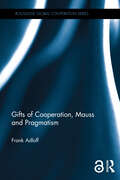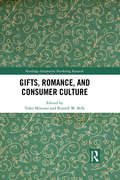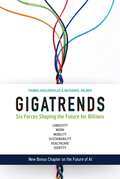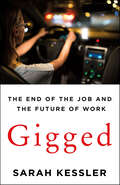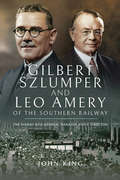- Table View
- List View
Gift-Giving, Gift-Taking und Gift-Exchange zur Gewinnung von Freiwilligen: Theoretische Modelle und ein Feldexperiment (BestMasters)
by Maximilian Alex KuntzeIn diesem Buch wird die Wirkung eines bedingungslos angebotenen Geschenks (Geschenkaustausch, Gift-Exchange) sowie einer kleinen vorangegangenen Bitte (Fuß-in-der-Tür-Technik, Foot-in-the-door-technique) auf die Bereitschaft, Freiwilligenarbeit zu leisten, untersucht.Es werden Mechanismen und Erklärungsansätze des Geschenkaustauschs diskutiert, theoretische und experimental-methodische Ansätze vorgeschlagen sowie der Einsatz und die Wirkung von Geschenken und einer kleinen Bitte im Feld erprobt. Hierzu werden stark rezipierte formal-mathematische theoretische Modelle adaptiert und weiterentwickelt, ein großangelegtes natürliches Feldexperiment durchgeführt sowie Literatur zu experimenteller und theoretischer Evidenz diskutiert.Thematisiert werden schwerpunktmäßig• Aversion gegenüber vorteilhafter Ungleichheit• Präferenzen für reziprokes Erwidern• Wahrgenommene Selbstwahrnehmung des eigenen Verhaltens mit direkten Auswirkungen auf eigene Präferenzen• Vermeidung kognitiver Dissonanz bedingt durch inkonsistentes Verhalten
Gifts from the Mountain: Simple Truths for Life's Complexities
by Eileen McDargh“Wonderfully profound …. It's as if Thoreau meets Lao Tzu on the trail and we are fortunate enough to overhear their wisdom on what the wilderness has to offer 21st century civilization.”— Jeff Salz, PhD, explorer, adventurer, anthropologist, and author of The Way of AdventureWhether you are a world-weary worker juggling the demands of a hectic life or a seeker of soul-satisfying experiences, this deceptively simple book is your key to refresh, renew, rethink, and recharge. From an unexpectedly arduous backpacking trip, Eileen McDargh discovers truths from the experience. Deep in grime, grit, and grace-filled mornings, she finds insights for business, for relationships, for family, for life, and for the soul.Just as the ocean inspired Anne Morrow Lindbergh's classic, Gifts from the Sea, so too can a mountain become a lyrical metaphor for coping with life's complexities. Whether musing on wild onions or mosquitoes, river crossings or thunderbolts, Eileen shares lessons for understanding the mundane and the magnificent, the difficult and the delightful, the ordinary and the extraordinary. Mountains become a lyrical metaphor for coping with life's complexities. You'll be reminded of what you may already know but have likely forgotten in the tension of time constraints, work worries, and family frustrations. McDargh will jar your memory, evoke new awareness, and spur you to action. Each two-page spread features a full-color watercolor painting illuminating these concise, graceful reflections. Gifts from the Mountain helps us pay attention to the process of life and to take joy in the journey.
Gifts of Cooperation, Mauss and Pragmatism (Routledge Global Cooperation Series)
by Frank AdloffThis book focuses on the contribution of Marcel Mauss (1872-1950) to social theory and a theory of cooperation. It shows that Mauss’s essay "The Gift" (1925) can be seen as a classic of a pragmatist, interactionist and anti-utilitarian sociology. It critiques the dichotomy of self-interest and normatively orientated action that forms the basis of sociology. This conceptual dichotomization has caused forms of social interaction (that cannot be localized either on the side of self-interest or on that of morality) to be overlooked or taken little notice of. The book argues that it is the logic of the gift and its reciprocity that accompany and structure all forms of interaction, from the social micro to the macro-level. It demonstrates that in modern societies agonistic and non-agonistic gifts form their own orders of interaction. This book uniquely establishes the paradigm of the gift as the basis for a theory of interaction. It will be of great interest to researchers and postgraduates in social theory, cultural theory, political sociology and global cooperation, anthropology, philosophy and politics.
Gifts of Cooperation, Mauss and Pragmatism (Routledge Global Cooperation Series)
by Frank AdloffThis book focuses on the contribution of Marcel Mauss (1872-1950) to social theory and a theory of cooperation. It shows that Mauss’s essay "The Gift" (1925) can be seen as a classic of a pragmatist, interactionist and anti-utilitarian sociology. It critiques the dichotomy of self-interest and normatively orientated action that forms the basis of sociology. This conceptual dichotomization has caused forms of social interaction (that cannot be localized either on the side of self-interest or on that of morality) to be overlooked or taken little notice of. The book argues that it is the logic of the gift and its reciprocity that accompany and structure all forms of interaction, from the social micro to the macro-level. It demonstrates that in modern societies agonistic and non-agonistic gifts form their own orders of interaction. This book uniquely establishes the paradigm of the gift as the basis for a theory of interaction. It will be of great interest to researchers and postgraduates in social theory, cultural theory, political sociology and global cooperation, anthropology, philosophy and politics.
Gifts, Romance, and Consumer Culture (Routledge Interpretive Marketing Research)
by Russell W. Belk Yuko MinowaHow do people communicate their romantic feelings? Gift giving is one way. Giving and receiving of gifts is a characteristic of intimate relationships. Gifts are a message, a form of communication with a tangible material object, about love, affection, or concern for the recipient. The "romantic gift" evokes a multitude of intertwined meanings: passion, intimacy, affection, persuasion, care, celebration, altruism, and nostalgia. They can also connote the negative images of obligation and reciprocity. Romantic gift giving may be practiced at rituals, during rites of passage, or for casual occasions, to affirm the continued importance of the romantic relationship. We may even romanticize the giving of gifts to the self, to nonhuman companions, and to others we do not know personally. If loving and giving are a practice, then romantic gift giving is a practice of loving with intimate—or would-be intimate—others. This book addresses gift giving among consumers attempting to express and construct romantic love. It lies at the intersection of consumption, markets, and culture. In societies shaped by the globalizing neo-liberal economic order, increasing wealth disparity, and a partially digitized social environment that they help to co-construct, it may be time to rethink romantic love. Gift giving is a key arena to do so, as gifts make love tangible and act as carriers of meaning as well as cultural symbols. In gift giving the meanings of romance are renewed, renegotiated, and reconstructed. Gifts, Romance, And Consumer Culture demonstrates a wide variety of scholarly work bearing on romantic gift giving using an interpretive consumer research perspective. The book introduces critical studies by scholars in this unfolding and new interdisciplinary field.
Gigatrends: Six Forces That Are Changing the Future for Billions
by Thomas Koulopoulos Nathaniel PalmerGigatrends offers a roadmap for navigating six of the most disruptive trends shaping the future.Humanity stands at the precipice of a remarkable new era in global history filled with both immense opportunities and daunting challenges. Gigatrends examines how six disruptive trends can be harnessed to create new social, economic, and organizational solutions that will usher in the promise of a human-centered future for billions of people. But moving forward won&’t be easy. Gigatrends will disrupt nearly every existing socioeconomic system built over the past three hundred years. Navigating these seismic shifts will require a new set of skills, frameworks, and tools to help us move forward. Gigatrends will provide you with the insights to: • Understand how each of the six Gigatrends will shape your future • Predict how digital workers and AI will reshape the workforce • Create new social, economic, and organizational global ecosystems • Navigate the seismic shifts of a rapidly changing and uncertain world • Achieve a human-centered future that works for all of humanity • Recognize how digital identity will create a new era of prosperity The world is at an inflection point. It's time to understand and embrace the revolutionary power of Gigatrends to shape a future that&’s filled with hope and opportunity for all of humanity.
Gigged: The End of the Job and the Future of Work
by Sarah Kessler"With deep reporting and graceful storytelling, Sarah Kessler reveals the ground truth of a key part of the American workforce. Her analysis is both astute and nuanced, making GIGGED essential reading for anyone interested in the future of work." —Daniel H. Pink, author of WHEN and DRIVEThe full-time job is disappearing—is landing the right gig the new American Dream?One in three American workers is now a freelancer. This “gig economy”—one that provides neither the guarantee of steady hours nor benefits—emerged out of the digital era and has revolutionized the way we do business. High-profile tech start-ups such as Uber and Airbnb are constantly making headlines for the disruption they cause to the industries they overturn. But what are the effects of this disruption, from Wall Street down to Main Street? What challenges do employees and job-seekers face at every level of professional experience?In the tradition of the great business narratives of our time, Gigged offers deeply-sourced, up-close-and-personal accounts of our new economy. From the computer programmer who chooses exactly which hours he works each week, to the Uber driver who starts a union, to the charity worker who believes freelance gigs might just transform a declining rural town, journalist Sarah Kessler follows a wide range of individuals from across the country to provide a nuanced look at how the gig economy is playing out in real-time.Kessler wades through the hype and hyperbole to tackle the big questions: What does the future of work look like? Will the millennial generation do as well as their parents? How can we all find meaningful, well-paid work?
Gilbert Szlumper and Leo Amery of the Southern Railway: The Diaries of a General Manager and a Director
by John KingVery few diaries of directors and senior managers of the Big Four railways have survived to enter the public domain. There are, however, two notable Southern Railway diarists whose records have been available in archives for some years, but have been largely ignored by historians; Southern Railway General Manager Gilbert Szlumper and Director Leopold Amery. Their remarkable diaries are addressed in this insightful book, which gives a slightly different view of the company in contrast to the almost sanitized histories by some writers.The surviving diaries of Szlumper are far from complete. They begin in 1936 and continue into the war years, but there are several gaps. Throughout, Szlumper comments on individuals and developments, revealing little-known facts and the circumstances that meant he could never truly achieve his potential. Formally retiring in 1942, he died in 1969, after which his diaries entered the public domain.Leopold Amery was director of the Southern Railway from 1932. A Birmingham Member of Parliament for many years, he was a statesman of some stature, his high offices including Secretary of State for the Colonies in the 1920s. In his autobiography, Amery writes very little on the railway, although he does comment on its family atmosphere. His diaries, which are in the public domain in a Cambridge University archive, have been published in two volumes but Amerys fascinating business activities were omitted by the publisher, and like Szlumper he comments on individuals and developments.The diary information of these two exceptional men has been supplemented by information from the railway, state archives and other sources, and many of the photographs have never been published before.
Gilberto Dimenstein and Community Empowerment in Brazil (A)
by Rosabeth Moss Kanter Ai-Ling Jamila Malone Alexandre NaghirniacIn 2011, Gilberto Dimenstein, a well-known Brazilian journalist, created a new model that connected disparate resources to revitalize Sao Paulo. He wanted his model to expand across Brazil and the world. Dimenstein covered many of the social issues facing Brazil as a journalist and became determined to create solutions. Dimenstein started two social ventures, ANDI and Escola Aprendiz, before creating and developing Catraca Livre (meaning "open turnstile" in Portuguese) while he was an Advanced Leadership fellow at Harvard. Dimenstein pursued his idea of "learning neighborhoods", which meant a localized, low cost and effective way to leverage the existing available resources as educational opportunities. The resources were underutilized because of a lack of awareness. He believed that education should not be limited to the classroom and instead should be expanded to the entire city. Catraca Livre enabled Sao Paulo's residents to utilize untapped resources by aggregating all of the available resources and disseminating the information through multiple avenues including a website, subways, restaurants, workplaces, and more. This case shows how Dimenstein spearheads his solution to improve his city and offers a model for revitalizing cities around the world.
Gilded: Breaking Free from the Cage of Ambition, Perfectionism, and the Relentless Pursuit of More
by Keren EldadBreak Free from the Trap of Ambition &“I highly recommend Keren Eldad&’s new book, GILDED, which comes at a time when many people are struggling with the strictures of ambition and perfectionism. Keren&’s approach gives readers the power to break free from the trance of pursuing &‘more&’ and celebrate the present moment.&” –– Gay Hendricks, NYT bestselling author of The Big Leap GILDED by Keren Eldad is the go-to guide for overachievers and high performers who feel trapped in the endless cycle of chasing success. If you're ready to break free from perfectionism anxiety and discover true fulfillment, this book will guide you toward a life of authenticity and freedom. Are you an overachiever who feels unfulfilled despite your success? For those driven by ambition, perfectionism, and a relentless pursuit of more, it&’s easy to lose sight of what truly matters. In GILDED, Keren Eldad explores why so many high performers—whether C-suite executives or go-getters—feel trapped by the very success they sought, finding themselves unfulfilled despite outward achievements. Do you want to break free from the pressure of always needing more? If you&’re tired of perfectionism anxiety and constantly moving the goalposts of success, GILDED offers a fresh perspective. Drawing from executive coaching and personal experiences, Eldad provides practical strategies to help you step out of the gilded cage, stop chasing hollow victories, and start living a life of genuine abundance and fulfillment. Inside, you&’ll find: Actionable strategies to overcome perfectionism anxiety and embrace self-reflection for lasting personal growth. Practical insights for high performers and leaders who seek purpose beyond external success. Tools from executive coaching designed to help you redefine your ambitions and live authentically. If you liked other leadership development books such as The Coaching Habit, High Performance Habits, or Why Smart, Creative and Highly Sensitive People Hurt, you&’ll love GILDED.
Gilead Sciences: Developing a Biopharmaceutical Pipeline Through M&A
by Paul Clancy Amitabh Chandra Craig GarthwaiteCase
Gilead: Hepatitis C Access Strategy (B)
by V. Kasturi RanganWhile the Gilead: Hepatitis-C Access Strategy (A) case (515-025) poses questions on what the company should do with respect to hart hit countries like Egypt and India, this (B) case provides the answer. In both cases, the company chose to pursue a proactive strategy to enable access at affordable prices.
Gilead: Hepatitis-C Access Strategy (A)
by V. Kasturi Rangan David E. Bloom Vikram RanganGilead had come up with an innovative drug for Hepatitis C, which affected 180 million people worldwide. The drug was priced at $1,000 a pill for the US market. Gilead had to decide how to price and market the pill in developing countries that bore the brunt of the disease. The company had earned accolades for its work in HIV/AIDS, where its innovative medicines now accounted for 60% of all patients on Anti-Retroviral (ARV) medicines. Much of this was accomplished through generic licensing, which brought a $10,000/year treatment regimen down to $100! Should the company replicate that strategy for Hepatitis C? If so, how would its US Healthcare customers, who were paying $84,000 per patient, react? On the other hand, Gilead had to balance the interests of its shareholders, who paid $11 billion for an acquisition that led to the new Hepatitis C drug.
Gilead: Hepatitis-C Access Strategy (A)
by V. Kasturi Rangan David E. Bloom Vikram RanganGilead had come up with an innovative drug for Hepatitis C, which affected 180 million people worldwide. The drug was priced at $1,000 a pill for the US market. Gilead had to decide how to price and market the pill in developing countries that bore the brunt of the disease. The company had earned accolades for its work in HIV/AIDS, where its innovative medicines now accounted for 60% of all patients on Anti-Retroviral (ARV) medicines. Much of this was accomplished through generic licensing, which brought a $10,000/year treatment regimen down to $100! Should the company replicate that strategy for Hepatitis C? If so, how would its US Healthcare customers, who were paying $84,000 per patient, react? On the other hand, Gilead had to balance the interests of its shareholders, who paid $11 billion for an acquisition that led to the new Hepatitis C drug.
Gilead: Hepatitis-C Access Strategy (A) (Abridged)
by V. Kasturi Rangan David E. Bloom Vikram RanganGilead had come up with an innovative drug for Hepatitis C, which affected 180 million people worldwide. The drug was priced at $1,000 a pill for the US market. Gilead had to decide how to price and market the pill in developing countries that bore the brunt of the disease. The company had earned accolades for its work in HIV/AIDS, where its innovative medicines now accounted for 60% of all patients on Anti-Retroviral (ARV) medicines. Much of this was accomplished through generic licensing, which brought a $10,000/year treatment regimen down to $100! Should the company replicate that strategy for Hepatitis C? If so, how would its US Healthcare customers, who were paying $84,000 per patient, react? On the other hand, Gilead had to balance the interests of its shareholders, who paid $11 billion for an acquisition that led to the new Hepatitis C drug.
Gillette Co. (A): Pressure for Change
by Rosabeth Moss Kanter James WeberAfter years of strong performance with market-dominating brands, Gillette's performance slips and a new CEO is selected from outside the company to lead a turnaround. This case describes the business and financial situation he inherited and asks what he should do during his first day and week on the job.
Gillette Co. (B): Leadership for Change
by Rosabeth Moss Kanter James WeberDescribes the actions and behavior of a new CEO in his first days and weeks as he sets expectations for his top management team and introduces processes and disciplines to begin the turnaround of a global consumer products company.
Gillette Co. (C): Strategies for Change
by Rosabeth Moss Kanter James WeberExamines the strategic change agenda set by a new CEO as the initial priorities in the turnaround of this leading global consumer products company.
Gillette Co. (D): Implementing Change
by Rosabeth Moss KanterHow a strategic change agenda is implemented depends on leaders below the top in every function and geographic region translating the agenda into actions. But those actions do not always unfold as planned. This case examines the first 16 months of a turnaround from the perspective of implementers in the field. It describes business issues, organizational design dilemmas, and the cultural and behavioral challenges of implementing change in a global company.
Gillette Company (E): Procter & Gamble
by Rosabeth Moss Kanter Matthew BirdAfter arriving in 2001 as the first outsider Chairman and CEO in Gillette history, Jim Kilts had led a remarkable turnaround. But by late 2004 he had to make a difficult decision. To better position the 104-year-old, Boston-based company, he opted to sell it to Cincinnati-based Procter & Gamble. How should Kilts lead the transition?
Gillette Indonesia
by John A. Quelch Diane LongThe country manager of Gillette Indonesia is reviewing his 1996 marketing plan and considering whether the pace of market development and mix of product sales can be impacted by the level and type of Gillette expenditures in the market.
Gillette Personal Care Division: Marketing Planning and Control
by Thomas V. Bonoma Bruce H. ClarkBill Ryan, president of the Gillette Co.'s Personal Care Division, is considering changing the division's planning and control system for marketing. White Rain, the division's most recent success, had been launched by taking shortcuts through the system, while other marketing programs the system produced sometimes still faltered. The case examines the components of a planning and control system for marketing, criteria for good systems and good programs, and ways that marketing managers work with a system.
Gillette Safety Razor Division: Blank Cassette Project
by Stephen H. StarGillette is trying to decide whether to enter the fast-growing blank recording cassette business. The vice president of new business development is charged with developing a marketing plan to be used as the basis for a go/no go decision. In part, the issue is whether Gillette can transfer its distinct competence to a new but related market. The problem is compounded by the rapid changes characteristic of a market early in its life cycle.


